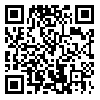BibTeX | RIS | EndNote | Medlars | ProCite | Reference Manager | RefWorks
Send citation to:
URL: http://journal.rums.ac.ir/article-1-1503-en.html
Background and Objective: Research on schizotypal
personality in general population may provide a particular opportunity to study
the different markers of vulnerability to schizophrenia without the confounding
effects of long term hospitalization, medication and severe psychotic symptoms.
The aim of this study was to evaluate the relationship between the some
demographic characteristics and the psychotic like traits.
Materials
and Methods: The
current study conducted in cross sectional research context. A group of 482 (294 female and 188 male)
normal participants from faculties of Shahidmadani University in the academic
year 2008-2009 was selected randomly (Mean age= 24, 58±1.44),
and answered to The Oxford- Liverpool Inventory of Feelings and Experiences
(OLIFE). Data were analyzed using Pearson's correlation coefficient, multiple
regression and independent t test.
Results: Results suggested that only
marriage status was significantly related to psychotic like traits (p<0.05, b=0.093),
and single students, in contrast to married, had significantly increased
schizotypy scores (p<0.001, t=4.31). Men have higher mean scores on impulsive nonconformity
factor (p<0.001,
t= 3.49), and there are no differences on total and other factors of schizotypy. With respect to other demographic
factors, results showed the effects are neglectable.
Conclusions: Results were explained in light of fear of intimacy
and aloneness symptoms in people with schizotypal traits.
Key
words: Psychotic
like traits, Schizotypy,
Schizophrenia, Demographic variables
Funding: This research was supported by research
committee of Shahid Madani University.
Conflict of
interest: None
declared.
Ethical approval:
The Ethics
Committee of University of ShahidMadani approved the study.
How to cite this
article: Yaghubi H, Mohammadzadeh
A, Najafi M, Ahmadi M. The Relation of Psychotic Like
Traits and some Demographic Variables among Students. J Rafsanjan Univ Med Sci 2014 12(12): 965-74.
[Farsi]
Received: 2012/10/6 | Accepted: 2013/09/30 | Published: 2014/04/19
| Rights and permissions | |
 |
This work is licensed under a Creative Commons Attribution-NonCommercial 4.0 International License. |






